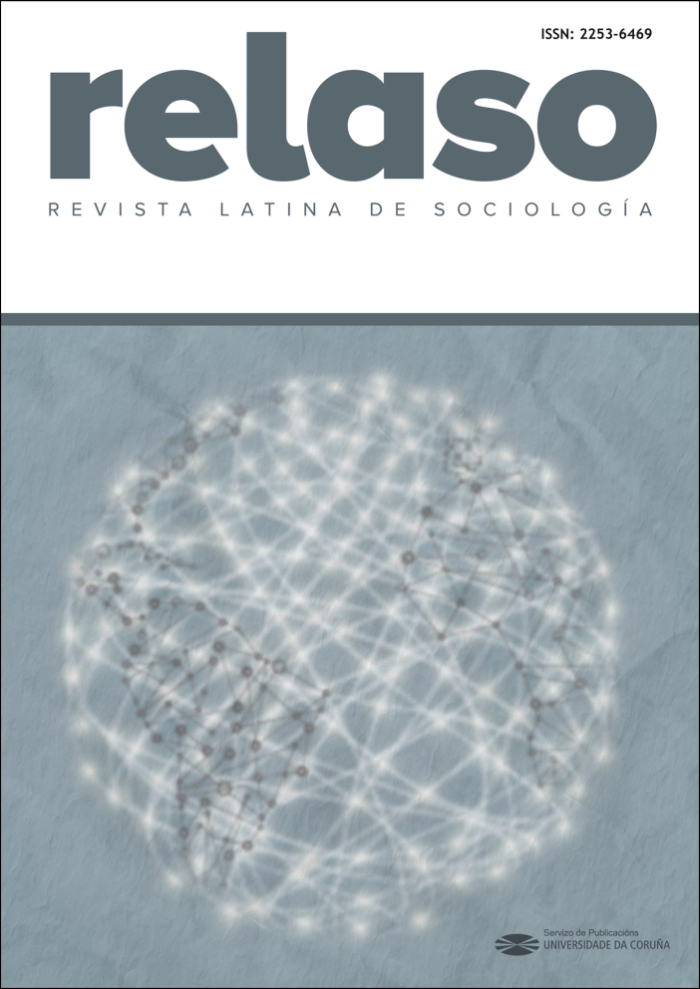Desigualdade social, prestígio ocupacional, renda e educação. Proposta para uma escala no Uruguai
Contido principal do artigo
DOI:
https://doi.org/10.17979/relaso.2019.9.1.5222Resumo
No âmbito do Levantamento de Mobilidade Social e Trajetórias Educacionais (EMOTE 2010-2012), foi realizada uma pesquisa de prestígio ocupacional, aplicando um conjunto de perguntas específicas sobre este tópico. Foi aplicado a uma subamostra representativa de pesquisa, que totalizou 427 casos, de ambos os sexos, maiores de 18 anos, nas cidades de Montevidéu, Maldonado e Salto (Uruguai). O interesse pelo trabalho foi múltiplo, mas partiu da tentativa de estabelecer se os entrevistados puderam dar uma opinião indicativa sobre o prestígio das ocupações e a desigualdade social. Com a amostra, um conjunto de 90 ocupações que representou a maioria das ocupações presentes na Pesquisa Nacional Ampliada 2006 (ENAH). Os entrevistados foram convidados a avaliar o prestígio de um conjunto de ocupações com pontuação entre 1 e 9, correspondendo a 1 eles consideraram os menos prestigiosos e 9 os mais prestigiosos. Aparecendo abaixo sua validação e uma aplicação.
Palavras-chave:
Detalles do artigo
Referências
Acosta, L; Jorrat, R. 2004 “Escalas de prestigio y status socio-económico de las ocupaciones”; Editorial Dunken, Bs. As.
Blau, P; Duncan, O. 1967 “The american ocupational structure”; John Wiley, New York.
Boado, M 2017 “Clivajes y linajes en la movilidad social: una aproximación al desarrollo de una tradición teórica exigente”; Revista Latina de Sociología, Vol 6 Nº 2, Universidade da Coruña. https://doi.org/10.17979/relaso.2016.6.2.1972
Boado, M; Rey, R. (2017) Prestigio ocupacional y desigualdad social: una escala para Uruguay. En Pucci (compilador) El Uruguay desde la Sociología N°15, Udelar, FCS, DS. Montevideo.
Chambaz, C; Morin E; Torelli, T (1998) “L’evaluation sociale des professions en France”; Revue Francaise de Sociologie, Vol XXXIX, pp 177-226.
Davis, P; McLeod, K; Ransom, M; Ongley, P. 1997 “The New Zealand Socioeconomic Index of Occupational Status (NZSEI)”; Research Report #2; Statistics New Zealand, Wellington.
Chan, Tak Wing y John H. Goldthorpe. 2007. “Class and Status: The Conceptual Distinction and its Empirical Relevance”. American Sociological Review 72: 512-532.
Duncan, O, 1961 “A social Economic Index for all occupations”; in Reiss E, et al “Occupations and social status”. Glencoe Free Press, NY.
Ganzeboom, H; Treiman, D; 1991 “Three Internationally Standardised Measures for Comparative Research on Occupational Status”; Annual Review of Sociology; Vol 17, pp. 277-302. Annual Reviews Inc.
Hodge, R; Siegel, P; Rossi, P. 1964 “Occupational Prestige in the United States, 1925-63”; American Journal of Sociology, Vol. 70, No. 3 (Nov. 1964), pp. 286-302.
Marks, G; McMillan, J; Jones, FL; Ainley, J 2000 “The Measurement of Socioeconomic Status for the Reporting of Nationally Comparable Outcomes of Schooling”; Australian Council for Educational Research & Sociology Program Research School of Social Sciences Australian National University National Education Performance Monitoring Taskforce (Draft Report), Sidney.
Nakao, K; Treas, J “The 1989 socioeconomic index of occupations: construction from the 1989 occupational prestige scores”; GSS Methodological Report No. 74, Irvine.
Nam, Charles B., and Monica Boyd. 2004 “Occupational status in 2000. Over a century of censusbased measurement”; Population Research and Policy Review, 23: 327-358.
Nam, Charles B., and E. Walter Terrie. 1988. 1980-Based Nam-Powers Occupational Status Scores. Florida State University, Center for the Study of Population, Working Paper Series, WPS 88-48.
Shils, E.A. (1968). “Deference”; in: J.A. Jackson (Ed.), Social Stratification. Cambridge: Cambridge University Press.
Treiman, D.J. (1977). Occupational Prestige in Comparative Perspective. New York: Academic Press.


